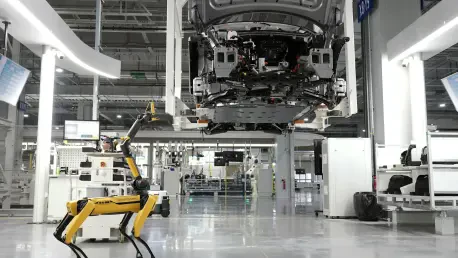The manufacturing industry, a pillar of economic development, continually seeks ways to enhance efficiency, minimize costs, and improve operational safety. In recent years, integrating the Internet of Things (IoT) and Artificial Intelligence (AI) technology has emerged as a game-changer in predictive maintenance. This transformative approach redefines traditional maintenance paradigms by anticipating equipment failures before they occur, thus reducing costly downtimes and enhancing overall operational reliability. As industries become increasingly competitive, leveraging these technologies offers a strategic advantage by ushering in an era of informed and proactive management strategies.
Economic and Operational Benefits
Reducing Unplanned Downtime
Unplanned downtime has long plagued industrial manufacturers, costing the sector billions annually. Equipment failures often dominate these costs, accounting for a significant portion of financial losses due to unscheduled halts in production. With IoT sensors meticulously monitoring variables like vibration, temperature, oil quality, and energy consumption, a detailed benchmark for normal equipment functioning is established. This paradigm shift allows operators to receive early warnings of potential deviations, paving the way for timely interventions. The subsequent reduction in unplanned downtime not only preserves financial resources but also optimizes productivity levels, providing companies a competitive edge.
Advanced Analytical Capabilities
AI forms the backbone of the predictive maintenance revolution by offering advanced analytical capabilities that traditional methods cannot rival. Through the assimilation of extensive sensor data, AI pinpoints potential faults, estimates component longevity, and prioritizes repair tasks. Moreover, AI solutions can generate optimal maintenance schedules, ensuring that machinery operates at its peak efficiency. The ability to predict issues before they manifest means that industries experience fewer interruptions and extend the lifespan of expensive equipment. Consequently, businesses report not only significant reductions in maintenance-related expenses but also enhanced equipment effectiveness and improved operational metrics.
Enhancing Safety and Sustainability
Optimizing Maintenance Safety Measures
Predictive maintenance does more than just preserve functionality; it also enhances workplace safety. By maintaining comprehensive digital records and issuing timely alerts, the system ensures that equipment remains in safe operational condition. This reduces the chance of accidents caused by unexpected machinery failure. Additionally, tracking maintenance activities ensures that all necessary safety precautions are adhered to, minimizing risks to personnel. The proactive approach decreases workplace hazards and aligns with stringent industry safety standards, creating safer working environments for employees and reducing potential liability concerns for businesses.
Promoting Sustainable Practices
Sustainability is a crucial consideration for modern industries aiming to reduce environmental impact while improving cost efficiency. Predictive maintenance supports these goals by optimizing energy consumption, curbing waste, and effectively managing spare parts inventories. By calibrating operations to the exact needs of machinery, unnecessary energy expenditure is minimized, contributing to lower carbon footprints. As components are repaired or replaced based strictly on their condition rather than rigid schedules, the reduction in waste becomes evident. In the broader context, such practices reflect an organization’s commitment to environmentally responsible operations, meeting both regulatory requirements and consumer expectations for sustainable business practices.
Overcoming Challenges and Looking Ahead
Tackling Technical Challenges
While IoT and AI offer myriad benefits, integrating these technologies into existing manufacturing processes comes with its own challenges. The compatibility of legacy equipment with modern IoT devices is a primary concern, necessitating upgrades or adaptations. Furthermore, the data-driven nature of this approach demands significant resources for AI model training. Investing in upgrading the workforce’s skills is also vital, ensuring technicians and operators can effectively manage and interpret new systems. Nonetheless, the continuous progress in cloud computing and the advent of intuitive IoT devices mitigate these challenges. Companies are increasingly adopting hybrid systems to bridge the gap between traditional machinery and modern technology.
Future Prospects
The future of predictive maintenance in manufacturing looks brighter as technological innovations continue to evolve. The integration of digital twins—virtual models that offer real-time diagnostics—and enhanced AI decision-making support are on the horizon. Automated systems are anticipated to dynamically adjust processes based on predicted risks, further pushing the boundaries of efficiency and operational resilience. As industries adapt to these advancements, the focus shifts toward fully digital, AI-driven maintenance strategies, paving the way for seamless operations in the manufacturing sectors of tomorrow.
Shaping the Manufacturing Landscape
The manufacturing sector, a cornerstone of economic growth, is constantly on the lookout for innovative ways to boost efficiency, cut costs, and enhance operational safety. Lately, the advent of the Internet of Things (IoT) combined with Artificial Intelligence (AI) has revolutionized the field of predictive maintenance. This cutting-edge approach marks a significant shift from traditional maintenance methods by predicting equipment failures before they happen. This proactive stance not only substantially cuts down on costly downtimes but also bolsters overall operational reliability. As the industrial landscape grows more competitive, the adoption of IoT and AI technology provides businesses with a crucial strategic edge. It fosters a new era of informed decision-making and proactive management strategies, setting the stage for enhanced competitiveness and efficiency. By leveraging these technological advancements, industries can optimize performance and stay ahead in today’s rapidly evolving market.









